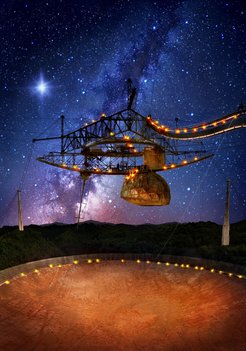A Repeating Fast Radio Burst in an Extreme Environment
Extragalactic source of energetic radio bursts resides in a strongly magnetized astrophysical region

The 305-metre Arecibo telescope, in Puerto Rico, and its suspended support platform of radio receivers is shown amid a starry night. A flash from the Fast Radio Burst source FRB 121102 is indicated, originating from deep in extragalactic space.
Using data from the Arecibo Observatory, Puerto Rico, and the Green Bank Telescope, West Virginia, astronomers have shown that the radio bursts from the enigmatic source FRB121102, the only repeating source of fast radio bursts (FRB) known so far, are highly polarized. The behavior of this polarized emission allows them to probe the source’s environment in a new way.
If polarized radio waves pass a region with a magnetic field, the polarization gets “twisted’’ by an effect known as Faraday rotation: the stronger the magnetic field, the greater the twisting. The amount of twisting observed in FRB121102’s radio bursts is among the largest ever measured in a radio source, and the researchers conclude that the bursts are passing through an exceptionally strong magnetic field in a dense plasma.
“The only sources in the Milky Way that are twisted as much as FRB121102 are in the Galactic center, which is a dynamic region near a massive black hole. Maybe FRB121102 is in a similar environment in its host galaxy,” says Daniele Michilli, PhD candidate at the University of Amsterdam and ASTRON, the Netherlands Institute for Radio Astronomy. “However, the twisting of the radio bursts could also be explained if the source is located in a powerful nebula or supernova remnant,” he adds.
Key to the discovery was detecting the bursts at higher radio frequency than ever before. “We developed a new observing setup at the Arecibo Observatory to do this, and our colleagues from Breakthrough Listen at the Green Bank Telescope confirmed the results with observations at even higher radio frequencies,” says Andrew Seymour, Staff Astronomer at Arecibo. “What’s more, the polarization properties and shapes of these bursts are similar to radio emission from young, energetic neutron stars in our galaxy. This provides support to the models that the radio bursts are produced by a neutron star,” he adds.
A year ago, the research team pinpointed the location of FRB121102 and reported that it lies in a star-forming region of a dwarf galaxy at a distance of over 3 billion light years from Earth. The enormous distance to the source implies that it releases a monstrous amount of energy in each burst - roughly as much energy in a single burst of one millisecond as the Sun releases in an entire day.
In addition to the most extreme twisting observed from any known FRB source, bursts from FRB121102 also show a more complicated structure in time and radio frequency. ”The profiles of the other known FRBs are simple with just one or occasionally two peaks in time. We’ve observed bursts from FRB121102 with as many as seven peaks, and the bursts peak in radio frequency as well as time,” says Laura Spitler, an astronomer at the MPIfR. “We are now trying to understand whether the bursts’ structure is an intrinsic feature of the process that generates the radio emission or the result of the propagation through the dense plasma local to the source.”
“We are continuing to monitor how the properties of the bursts change with time”, says Jason Hessels, University of Amsterdam & ASTRON. “With these observations we hope to distinguish between the two competing hypotheses of a neutron star either near a black hole or embedded in a powerful nebula.”
With a number of wide-field radio telescopes now coming online, more such sources are expected to be discovered in the coming years, and astronomers are poised to answer more fundamental questions about FRBs.
--------------------------------------------------------
The research team includes Daniele Michilli from University of Amsterdam and ASTRON, the first author, and Jason Hessels, also University of Amsterdam and ASTRON, Andrew Seymour from NAIC, Arecibo, Laura Spitler from MPIfR, Vishal Gajjar from Space Science Laboratory, University of California at Berkeley, followed by a number of additional co-authors: A.M. Archibald G. C. Bower, S. Chatterjee, J.M. Cordes, K. Gourdji, G. H. Heald, V.M. Kaspi, C. J. Law, C. Sobey, E. A. K. Adams, C. G. Bassa, S. Bogdanov, C. Brinkman, P. Demorest, F. Fernandez, G. Hellbourg, T. J. W. Lazio, R. S. Lynch, N. Maddox, B. Marcote, M. A.McLaughlin, Z. Paragi, S.M. Ransom, P. Scholz, A. P. V. Siemion, S. P. Tendulkar, P. Van Rooy, R. S. Wharton, D. Whitlow. MPIfR co-authors are Laura Spitler and Robert Wharton.
Laura Spitler is principal investigator of the Arecibo monitoring campaign. She acknowledges financial support from the ERC starting grant BEACON (contract no. 279702) and from Max Planck Society.
